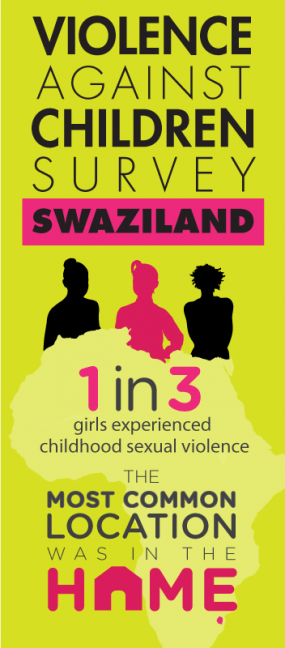Research Brief: One in three girls in Swaziland experience sexual violence in childhood
Background
Sexual violence against girls in childhood (before age 18) is a substantial global health and human rights problem. Despite concerns regarding sexual violence against girls, few studies have been done that measure the burden in sub-Saharan Africa. The Violence Against Children Survey (VACS) was conducted in Swaziland with a nationally representative sample of girls and young women ages 13-24 from selected households in 2007. The findings provide an estimate of the prevalence of sexual violence in childhood among girls in Swaziland, along with information about the perpetrators and circumstances of the violence. The study also includes findings on health-related conditions associated with experiencing sexual violence.
Key Findings
- One in three girls ages 13-17 – 33% – experienced sexual violence before age 18. Among women aged 18-24, 38% experienced sexual violence before age 18.
- One in six girls ages 13-17 – 16% – experienced sexual violence in the past year.
This paper is the first publication from a Violence Against Children Survey. It reports findings from the 2007 Swaziland VACS, which was the first VACS completed. In Swaziland, data were only collected for girls. This study was important for establishing the methodology of the VACS and for reporting the national prevalence of violence among children in Swaziland. This study lays the groundwork for VACS studies and reports across many future countries, which allows cross-national comparisons of the rates, circumstances, and consequences of violence.

The most common incidents of sexual violence were attempted forced intercourse, unwanted touching, and coerced intercourse.
- About one in 20 girls (5%) experienced physically forced sex (rape) before age 18, and nearly one in 10 (9%) experienced coerced sex (for example, through intimidation or threats).
- Sexual violence against girls was most commonly perpetrated by men or boys from the victim’s neighborhood (32%), followed by boyfriends or husbands (26%).
- Sexual violence most commonly occurred in the victim’s own home (26%), in a public area or field (23%), or at the house of a friend, relative, or neighbor (20%).
- Girls who experienced sexual violence were more likely than non-victims to feel depressed, think about suicide, have an unwanted pregnancy, have a sexually transmitted infection or a symptom of a sexually transmitted infection, have pregnancy complications or miscarriages, have problems sleeping, and use alcohol. Victims were not more likely to use cigarettes or have attempted suicide.
What is added by this report?
Sexual violence among young girls in Swaziland is common; one third of girls experienced some form of sexual violence. About three quarters of perpetrators of sexual violence were men or boys from the neighborhood, boyfriends, husbands, or male relatives. This indicates that perpetrators are either partners or known to the girls. This pattern emphasizes the vulnerability of girls. The common locations included public areas and homes. Victims of violence experienced significant mental and physical health problems, highlighting the need for prevention efforts to protect girls from serious health consequences as a result of violence, and response services to support the needs of victims.
Reza A, Breiding MJ, Gulaid J, Mercy JA, Blanton C, Mthethwa Z, Bambra S, Dahlberg LL, Anderson M. Sexual violence and its health consequences for female children in Swaziland: A cluster survey study. Lancet 2009; 373: 1966-1972. [hyperlink: http://www.thelancet.com/journals/lancet/article/PIIS0140-6736(09)60247-6/fulltextExternal
*Footnote: some variation between prevalence estimates from published papers and country reports may exist. This variation reflects slight differences in the subsamples and variables used in the analyses.